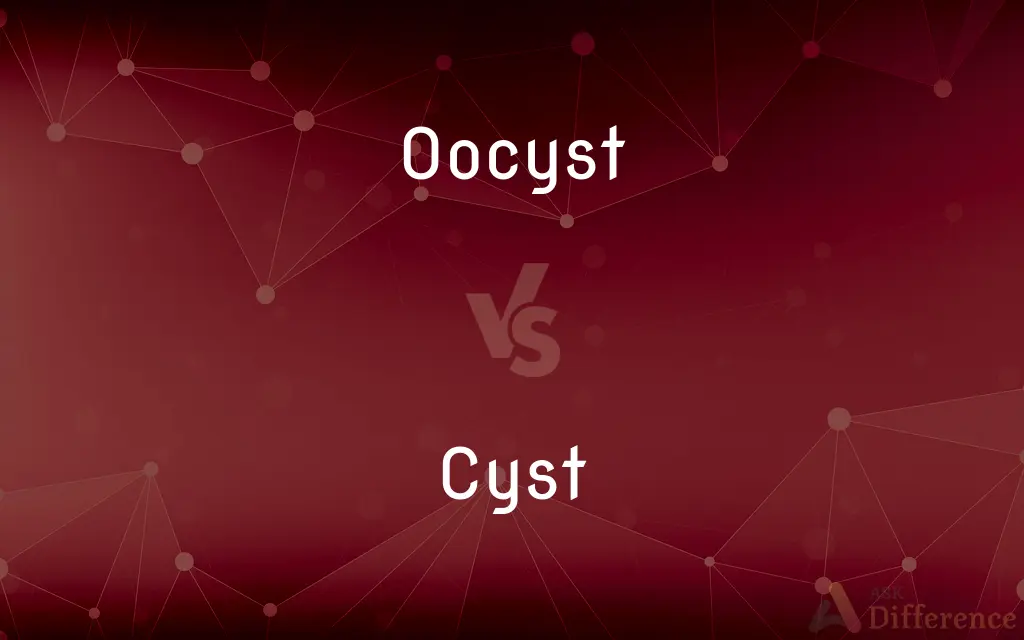Oocyst vs. Cyst — What's the Difference?
By Urooj Arif & Maham Liaqat — Updated on April 15, 2024
Oocysts are specialized cysts formed by certain protozoa for reproduction and survival in harsh environments, whereas cysts are general protective capsules found in various organisms, often for dormancy or protection.

Difference Between Oocyst and Cyst
Table of Contents
ADVERTISEMENT
Key Differences
Oocysts are formed by parasitic protozoa such as Cryptosporidium and Toxoplasma, primarily as part of their reproductive cycle. These structures allow the parasites to survive outside their host's body under unfavorable conditions. On the other hand, cysts can be formed by a variety of organisms, including bacteria, protozoa, and even higher animals and plants, serving primarily as a means of surviving adverse environmental conditions or as a method of spreading from one host to another.
While oocysts are specifically a form of reproductive cyst containing spores or zygotes, typical cysts may contain fluid, air, or semi-solid substances and do not necessarily play a role in reproduction. Oocysts ensure the continuation of the protozoan lifecycle by protecting the reproductive cells, whereas cysts may protect any type of cell, or even non-cellular material, from harm.
Oocysts are often highly resistant to environmental stresses such as chemicals and temperature extremes, which enables the encased spores to remain viable until they reach a suitable host or environment for growth. Cysts, on the other hand, might not always possess such high resistance but are still effective in safeguarding the organism during dormant phases.
The formation of oocysts is a well-defined stage in the life cycle of certain protozoans and is crucial for the spread of diseases like toxoplasmosis and cryptosporidiosis. Conversely, cyst formation can be a response to unfavorable living conditions and is not limited to disease-causing organisms but is a common survival strategy in many non-pathogenic species as well.
Comparison Chart
Definition
A specialized, spore-containing cyst formed by certain protozoa.
A protective capsule in organisms that may contain fluids or air.
ADVERTISEMENT
Function
Facilitates reproduction and transmission of protozoa.
Provides protection and survival mechanism during dormant phases.
Resistance
Highly resistant to environmental extremes.
Varies, generally less resistant than oocysts.
Relation to Host
Typically parasitic, requiring a host for lifecycle completion.
Can be parasitic, symbiotic, or independent.
Example Organisms
Cryptosporidium, Toxoplasma.
Bacteria, protozoa, plants, animals.
Compare with Definitions
Oocyst
A specialized cyst formed by protozoa for reproduction.
The oocyst of Toxoplasma gondii is crucial for its transmission between cats and humans.
Cyst
A capsule-like structure that encloses a dormant form of an organism.
The cyst enables the bacterium to survive until favorable conditions return.
Oocyst
A hardy, encysted form of certain parasites.
Oocysts can survive in chlorinated water, making them tough to eliminate.
Cyst
A protective case that can contain fluid, air, or solids.
Ultrasound revealed a benign cyst filled with fluid.
Oocyst
An infectious stage in the lifecycle of protozoans.
Handling cat litter carelessly can expose individuals to infectious oocysts.
Cyst
A form of biological containment or quarantine.
The cyst prevents the spread of the infection while the immune system combats the pathogen.
Oocyst
A stage for dissemination of parasitic protozoa.
Oocysts released into the environment can infect a wide range of hosts.
Cyst
A survival mechanism in both parasitic and non-parasitic species.
Cysts in the soil help fungi survive through dry periods.
Oocyst
A microscopic, thick-walled spore.
Oocysts observed under the microscope confirmed the diagnosis of cryptosporidiosis.
Cyst
A biological strategy for surviving adverse conditions.
Many aquatic invertebrates form cysts to overwinter.
Oocyst
A thick-walled structure that contains the zygote of an apicomplexan parasite and releases the infective sporozoites.
Cyst
A cyst is a closed sac, having a distinct envelope and division compared with the nearby tissue. Hence, it is a cluster of cells that have grouped together to form a sac (like the manner in which water molecules group together to form a bubble); however, the distinguishing aspect of a cyst is that the cells forming the "shell" of such a sac are distinctly abnormal (in both appearance and behaviour) when compared with all surrounding cells for that given location.
Oocyst
A reproductive cell in certain fungi.
Cyst
An abnormal membranous sac in the body containing a gaseous, liquid, or semisolid substance.
Oocyst
(biology) A thick-walled spore in the lifecycle of some parasitic protozoans that develops into sporozoite.
Cyst
A sac or vesicle in the body.
Cyst
(Biology) A small capsulelike sac that encloses certain organisms in their dormant or larval stage.
Cyst
(Botany) A thick-walled resting spore, as in certain algae or fungi.
Cyst
A pouch or sac without opening, usually membranous and containing morbid matter, which develops in one of the natural cavities or in the substance of an organ.
Cyst
(medicine) Of or pertaining to the urinary bladder or gall bladder (in compounds).
Cystectomy, cystitis, cystoscopy
Cyst
A pouch or sac without opening, usually membranous and containing morbid matter, which is accidentally developed in one of the natural cavities or in the substance of an organ.
Cyst
One of the bladders or air vessels of certain algæ, as of the great kelp of the Pacific, and common rockweeds (Fuci) of our shores.
Cyst
A small capsule or sac of the kind in which many immature entozoans exist in the tissues of living animals; also, a similar form in Rotifera, etc.
Cyst
A closed sac that develops abnormally in some body structure
Cyst
A small anatomically normal sac or bladderlike structure (especially one containing fluid)
Common Curiosities
Can cysts be infectious?
Yes, some cysts, particularly those formed by parasitic organisms, can be infectious.
What is the primary function of an oocyst?
The primary function of an oocyst is to protect and transport the reproductive cells of protozoans, ensuring the spread and continuation of their lifecycle.
What is an oocyst?
An oocyst is a type of cyst formed by protozoa, containing spores or zygotes, used for reproduction and survival.
Why are oocysts particularly resistant?
Oocysts are designed to withstand harsh environmental conditions to ensure the survival of the protozoan spores they contain.
Can the formation of cysts be induced?
In some cases, certain environmental stresses can induce organisms to form cysts.
What environmental conditions can oocysts withstand?
Oocysts are resistant to many environmental extremes, including disinfectants like chlorine.
Can cysts form in any part of the body?
In animals and humans, cysts can form in virtually any part of the body, often encapsulating foreign materials or infections.
What types of organisms form cysts?
Many organisms, including bacteria, protozoa, plants, and animals, can form cysts.
How do oocysts differ from typical cysts?
Oocysts are specialized for the reproductive cycles of protozoans and are highly resistant, whereas cysts are more general protective structures.
Are all cysts visible to the naked eye?
No, many cysts are microscopic, though some can grow to sizes that are visible.
How do oocysts aid in the transmission of diseases?
Oocysts can be excreted by an infected host and then ingested by another host, continuing the cycle of infection.
Are cysts always a sign of infection?
No, cysts can also be benign and not related to infections, particularly in animals and plants.
What are common diseases associated with oocysts?
Diseases such as toxoplasmosis and cryptosporidiosis are associated with the ingestion of oocysts.
How are oocysts diagnosed?
Oocysts can be diagnosed through microscopic examination of infected tissues or fluids.
Is treatment available for infections caused by oocysts?
Treatment varies depending on the protozoan species; however, preventing exposure to oocysts is a key measure.
Share Your Discovery

Previous Comparison
Fluorite vs. Fluoride
Next Comparison
Diffuser vs. NozzleAuthor Spotlight
Written by
Urooj ArifUrooj is a skilled content writer at Ask Difference, known for her exceptional ability to simplify complex topics into engaging and informative content. With a passion for research and a flair for clear, concise writing, she consistently delivers articles that resonate with our diverse audience.
Co-written by
Maham Liaqat














































